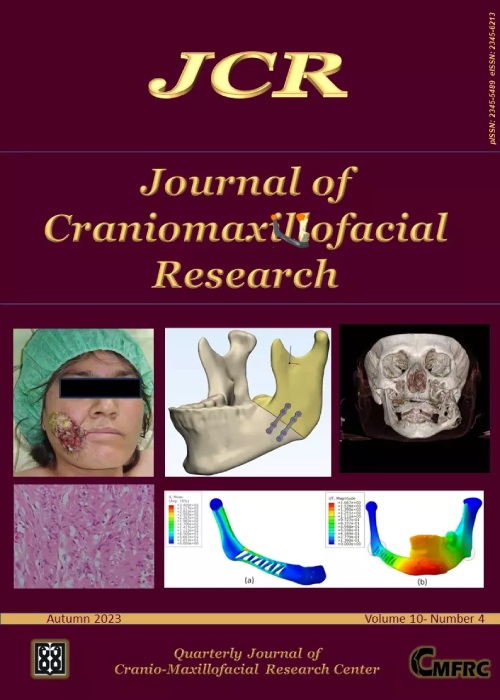The effect of mandibular advancement on signs and symptoms of the temporomandibular joint
Author(s):
Article Type:
Research/Original Article (دارای رتبه معتبر)
Abstract:
Statement of Problem: TMJ disorder is counted as one of the most problem in dentistry treatment with high prevalence. This disorder causes to pain. Since all of the structural defects do
not lead to pain, therefore in differential diagnosis of TMD, the signs and symptoms should be considered.
TMJ disorder, the researchers have not reached to agreement yet about the effect of orthognathic surgery on TMJ.
months post surgery.
duration of three months and 7.4 % after six months post surgery. The obtained results show that incidence of TMJ pain is greatly reduced at three months post surgery in comparison with pre
surgery results (p=0.02). In addition, the average of maximum mouth opening is reported as 47.6, 32.4 and 40.1 (mm) before surgery, three and six months afterwards (significant difference). Click disorder is reported 34.6% before surgery and 12.3% three months and 23.5% six months after surgery which demonstrates the remarkable reduction at time of three months later (p=0.0001) and six months after (p=0.004) in comparison with pre surgery.
temporomandibular click of patients with skeletal Cl II malocclusion.
not lead to pain, therefore in differential diagnosis of TMD, the signs and symptoms should be considered.
Purpose
The purpose of this study is to inspect the effect of mandibular advancement on signs and symptoms of the temporomandibular joint disorders (TMDs). Because of various etiologies of TMJ disorder, the researchers have not reached to agreement yet about the effect of orthognathic surgery on TMJ.
Materials and Method
A prospective descriptive trail of 81 patients with the range age between 19 and 31 years old with skeletal Cl II malocclusion that undergoes orthognathic surgery is carried out. For this purpose, the numbers of the male and female were considered to be 26 (32.1%) and 55 (67.9%). The most common features of TMDs are including pain, limitation of mandibular movement and joint sound which are assessed at three times pre surgery, three and six months post surgery.
Result
The incidence of TMDs at these three times is statistically analyzed by McNemar test. It is noteworthy that 11.1 % of the patients had TMJ pain pre surgery which changed to 2.5 % in duration of three months and 7.4 % after six months post surgery. The obtained results show that incidence of TMJ pain is greatly reduced at three months post surgery in comparison with pre
surgery results (p=0.02). In addition, the average of maximum mouth opening is reported as 47.6, 32.4 and 40.1 (mm) before surgery, three and six months afterwards (significant difference). Click disorder is reported 34.6% before surgery and 12.3% three months and 23.5% six months after surgery which demonstrates the remarkable reduction at time of three months later (p=0.0001) and six months after (p=0.004) in comparison with pre surgery.
Conclusion
This study is also illustrated that although orthognathic surgery has no signifi- cantly effect on the limitation of maximum mouth opening, it causes to improve the TMJ pain and temporomandibular click of patients with skeletal Cl II malocclusion.
Keywords:
Language:
English
Published:
Journal of Craniomaxillofacial Research, Volume:5 Issue: 4, Autumn 2018
Pages:
169 to 173
magiran.com/p1984382
دانلود و مطالعه متن این مقاله با یکی از روشهای زیر امکان پذیر است:
اشتراک شخصی
با عضویت و پرداخت آنلاین حق اشتراک یکساله به مبلغ 1,390,000ريال میتوانید 70 عنوان مطلب دانلود کنید!
اشتراک سازمانی
به کتابخانه دانشگاه یا محل کار خود پیشنهاد کنید تا اشتراک سازمانی این پایگاه را برای دسترسی نامحدود همه کاربران به متن مطالب تهیه نمایند!
توجه!
- حق عضویت دریافتی صرف حمایت از نشریات عضو و نگهداری، تکمیل و توسعه مگیران میشود.
- پرداخت حق اشتراک و دانلود مقالات اجازه بازنشر آن در سایر رسانههای چاپی و دیجیتال را به کاربر نمیدهد.
In order to view content subscription is required
Personal subscription
Subscribe magiran.com for 70 € euros via PayPal and download 70 articles during a year.
Organization subscription
Please contact us to subscribe your university or library for unlimited access!


